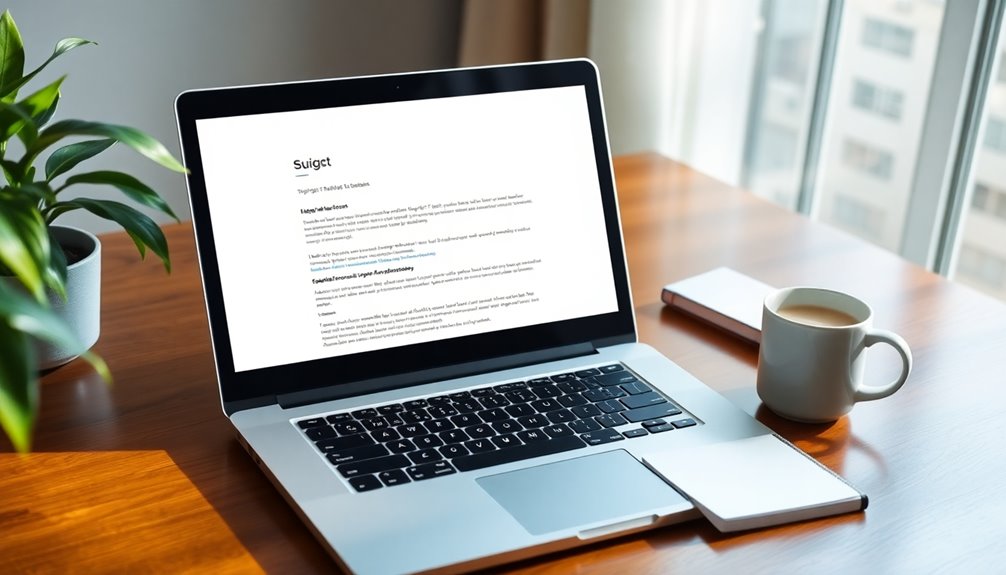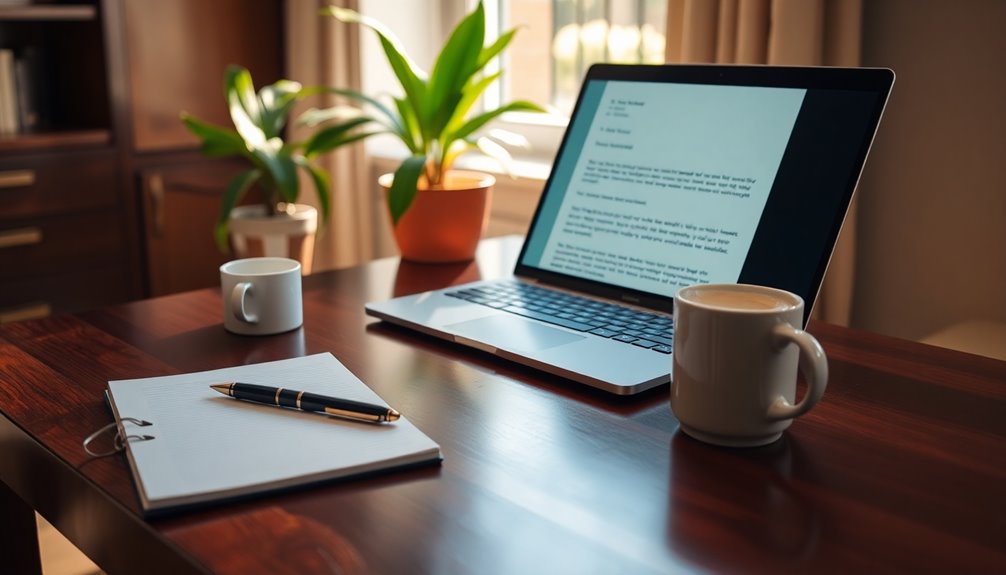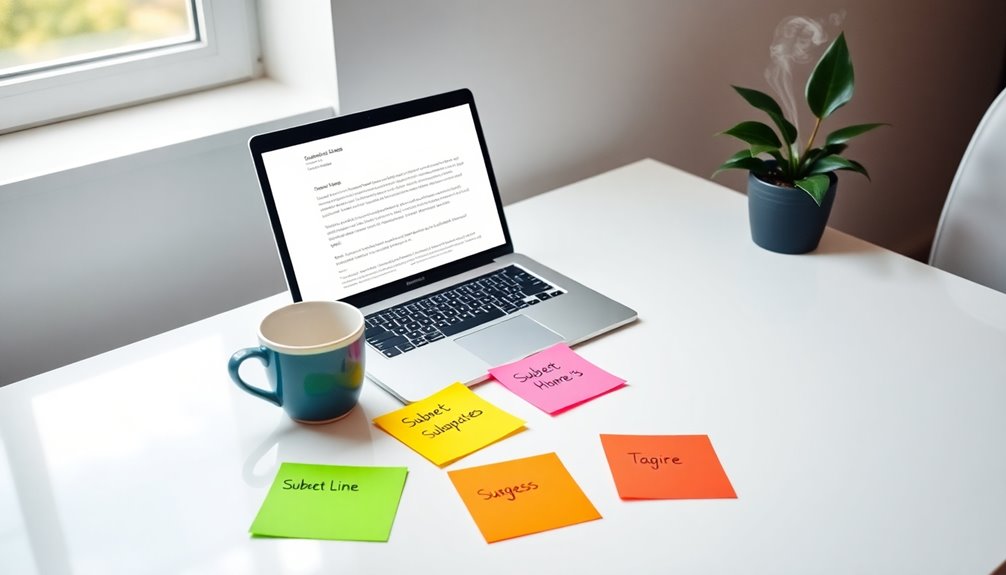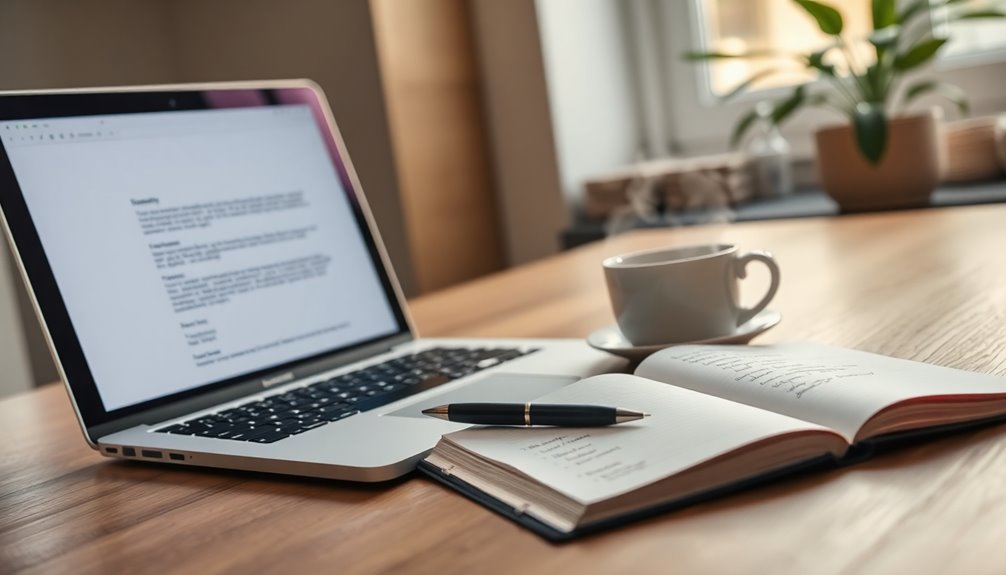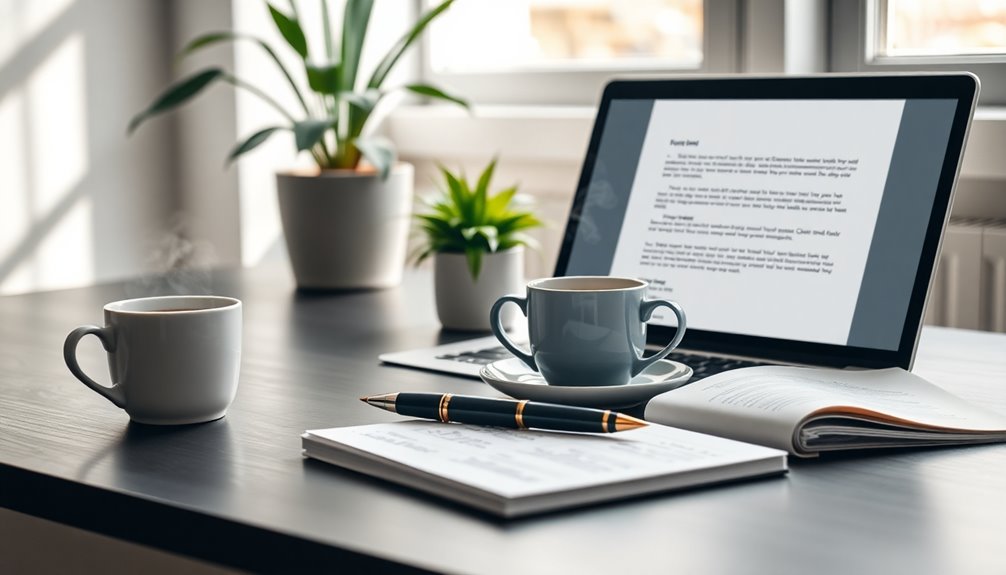To write a clear and effective email, start with a concise subject line that reflects your message. In the body, state your purpose early and keep your content organized; aim for under 200 words to maintain reader engagement. Use professional language and check for grammar errors to enhance your credibility. Include a clear call to action, guiding the recipient on the next steps. Always close with a courteous ending and add a professional signature. With these tips, you can improve your email communication significantly, and there's more useful advice just ahead!
Key Takeaways
- Start with a clear subject line that succinctly reflects the email's purpose to increase open rates.
- Organize the email with a brief introduction, a focused body, and a definitive conclusion.
- Use concise language, aiming for under 200 words to enhance readability and response likelihood.
- Maintain professionalism with proper grammar, tone, and a structured format throughout the email.
- Include a specific call to action and consider a follow-up to encourage prompt responses.
Introduction

When you sit down to write an email, the introduction sets the tone for the entire message. Start with a clear subject line that accurately reflects your email's content. This not only helps your recipient know what to expect but also increases the chances they'll open your email.
Next, begin with a polite greeting. If it's your first communication, a brief introduction of yourself can establish important context.
Once you've set the stage, it's crucial to state the purpose of your email right away. Clearly outlining your main message within the first few sentences helps eliminate confusion and keeps the recipient engaged.
Following that, include a specific call to action. This guides the recipient on what steps to take next, whether it's responding to a question or reviewing a document.
Maintaining a structured format with short paragraphs or bullet points enhances readability. This approach makes your email easier to follow and promotes effective communication.
Builds Professional Credibility

A well-crafted email can significantly boost your professional credibility. When you send professional emails, you show attention to detail and an understanding of workplace etiquette, which positively influences first impressions.
Start with clear subject lines, ideally under 60 characters, to convey your email's purpose. This not only enhances open rates by 20-30% but also signals your professionalism. Additionally, ensuring your emails are optimized for clarity can lead to better engagement and responses.
Use proper greetings and closings to set a respectful tone, which can strengthen your professional relationships. A warm yet formal approach indicates that you value the recipient and the communication process.
Make sure your emails are well-structured. Utilizing short paragraphs and bullet points makes your content easier to read and is 50% more likely to be thoroughly read. This clarity in your messaging fosters effective communication and reinforces your credibility.
Lastly, don't overlook the importance of proofreading. Grammar and spelling errors can undermine your professionalism, as 90% of professionals view these factors as critical. Moreover, maintaining professional standards in your written communication can enhance the overall perception of your reliability and competence.
Concise and Clear Language
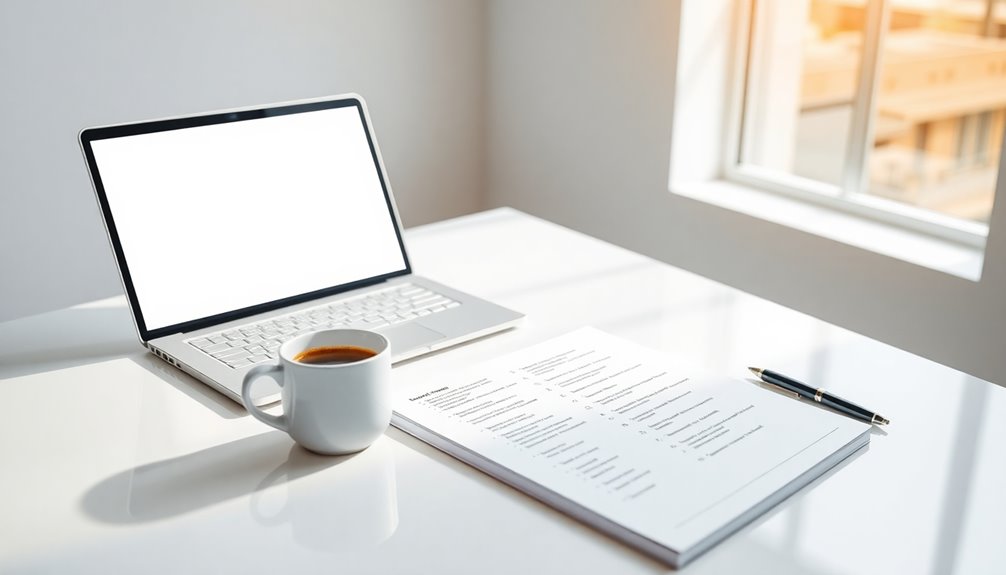
How can you ensure your email gets straight to the point? Start by embracing concise writing. Studies show that emails under 200 words receive higher response rates, so aim to keep your messages brief yet informative.
Use clear language to make it easy for your reader to grasp the main message quickly. Replace complex phrases with simpler words; for example, say "help" instead of "provide assistance." This not only streamlines communication but also enhances readability.
Organize your content using bullet points and short paragraphs to highlight key information. This layout allows recipients to scan your email efficiently and focus on what's essential. Avoid filler words and phrases that clutter your message; every word should serve a purpose in delivering your professional email's intent.
Using active voice can also boost clarity, making your sentences more direct and engaging.
Step-by-Step Email Structure Guide
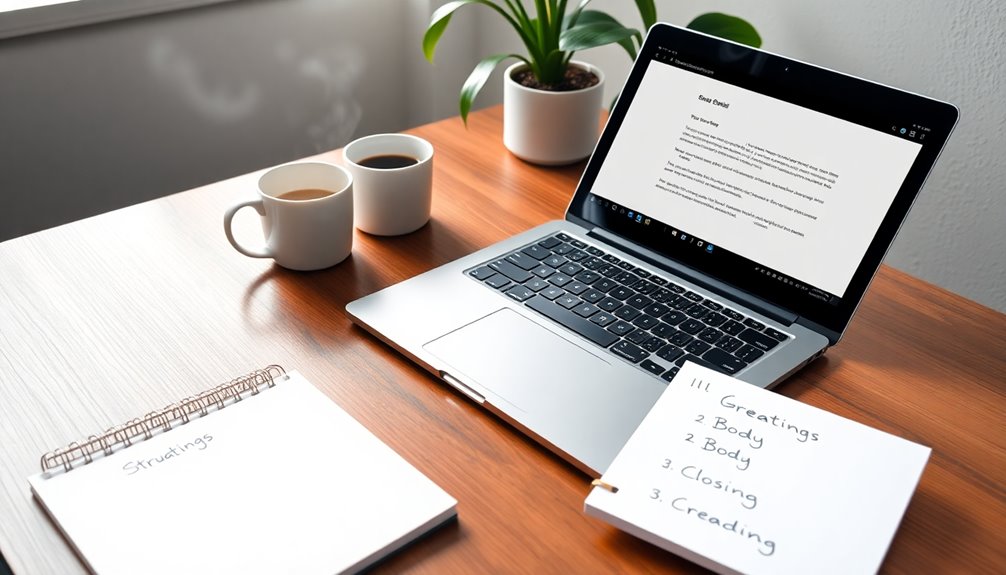
Crafting a well-structured email can significantly enhance your communication effectiveness. Start by creating a clear subject line that summarizes your email's content. Aim for a concise limit of 60 characters to capture attention immediately.
Next, begin with a formal greeting; if you're unfamiliar with the recipient, use their title and last name to maintain a professional tone.
In the first few sentences, clearly state the email's purpose. This helps the reader quickly identify the main message. To enhance readability, organize the body into short paragraphs or bullet points. This format makes it easier for recipients to grasp key information at a glance.
Don't forget to properly format your email to adhere to email etiquette. Conclude with a professional closing statement that reiterates your main point.
Most importantly, include a clear call to action, guiding the recipient on the expected next steps or responses. Using these email examples as a reference can help you achieve clarity and effectiveness in your communications.
Dos and Don'ts for Subject Lines
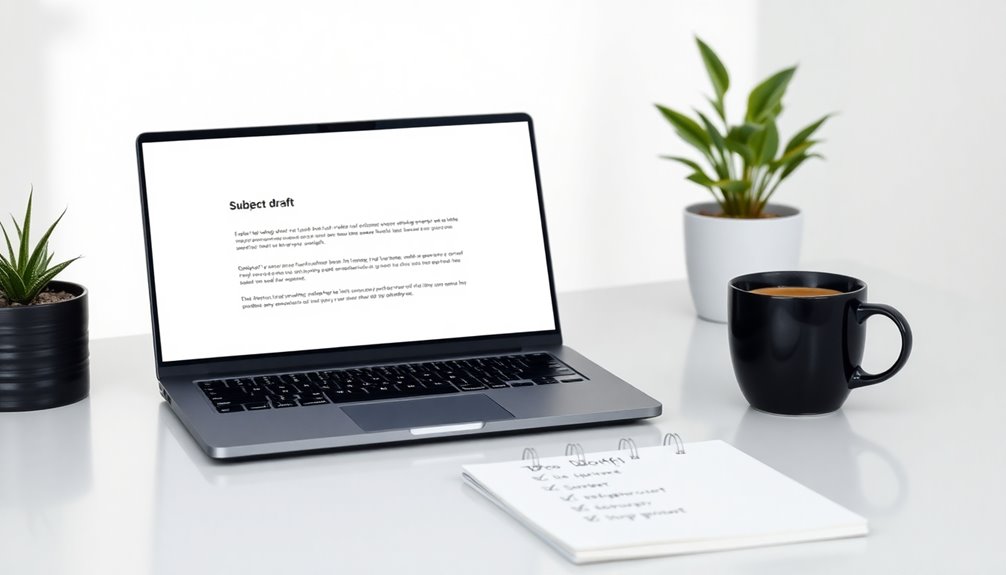
Creating an effective email structure sets the stage for a strong subject line. To grab your recipient's attention, be specific with your subject lines. Aim for clarity by summarizing the email's content in under 60 characters. This helps recipients know what to expect, increasing the chances they'll open your email.
Incorporate action-oriented language by using verbs and actionable phrases. For example, "Request for Feedback" or "Meeting Confirmation Needed" encourages engagement. Avoid vague terms; generic subject lines like "Hi" or "Important" lack context and may be ignored.
When necessary, prioritize urgency. If your email needs immediate attention, include phrases like "Urgent" or "Response Required By [Date]" to emphasize importance and prompt a timely response.
Lastly, don't forget to test for effectiveness. Consider A/B testing different subject lines to see which ones yield higher open rates. This way, you can refine your approach and make your email even more impactful.
Examples of Formal Emails

Formal emails play a crucial role in professional communication, setting the tone for your message and ensuring clarity. When crafting a professional email, start with a clear subject line that summarizes the email's content in a concise manner. For example, "Meeting Request: Project Update" keeps it under 60 characters and informs the recipient immediately.
Begin your email with a formal salutation, such as "Dear Ms. Smith," to establish professionalism. In the body, clearly state the purpose of your email. Use short paragraphs for better readability; for instance, outline the key points of your business proposal in separate sections.
Conclude your email with a courteous closing remark, like "Best regards," followed by your full name, title, and contact information. This adds a personal touch and reinforces your professionalism.
Don't forget to include a clear call to action at the end, guiding the recipient on the expected next steps. You might say, "Please let me know your availability for a meeting next week."
This ensures effective communication and encourages a prompt response, making your email both clear and effective.
Pro Tips for Writing Effective Emails
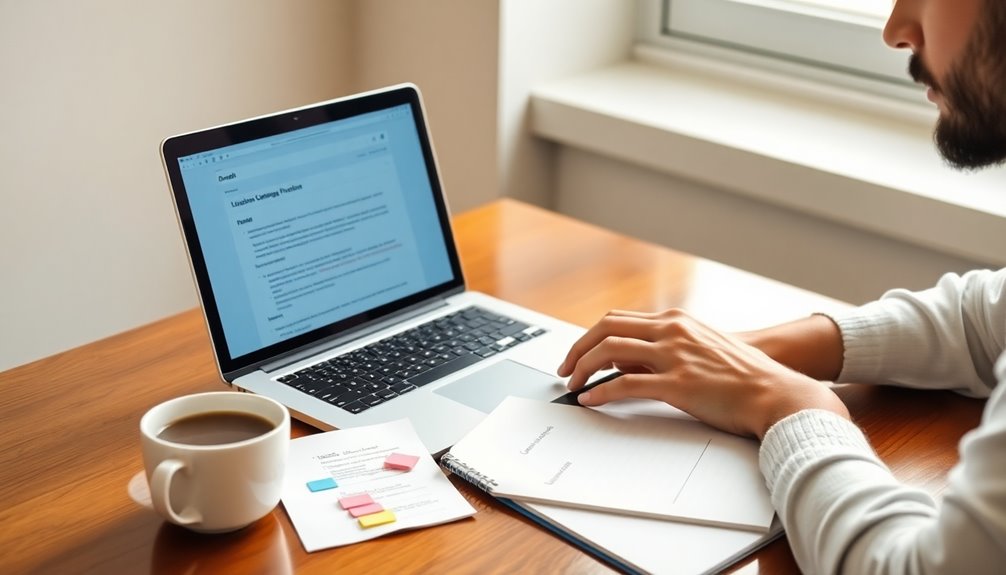
Effective emails can make a significant difference in your professional interactions. Start by crafting clear and concise subject lines that summarize the email's content, ideally keeping them under 60 characters. This increases open rates and grabs attention.
Begin your email with a positive greeting, and if it's your first time emailing a contact, introduce yourself briefly to establish context. State your main message and desired actions within the first few sentences. Avoid jargon to ensure your message is easily understood and prompts a quick response.
Organize your content into short paragraphs or bullet points. This enhances readability and respects the recipient's time, making it easier for them to grasp key points.
Lastly, always proofread your email for grammar and spelling errors before hitting send. A polished professional email reflects your attention to detail and commitment to clarity, making your communication more effective. Additionally, being aware of email etiquette can greatly improve your professional relationships and collaboration.
Final Thoughts

When it comes to email communication, keeping clarity at the forefront is essential. With 90% of professionals relying on email for work-related correspondence, effective writing can significantly reduce misunderstandings.
Always remember to start with a clear subject line—it can increase your open rates by up to 40%. Structure your email with a concise introduction, body, and conclusion to enhance readability. This format helps recipients skim through quickly, leading to faster replies. Additionally, maintaining high-quality content in your emails can enhance your credibility and trustworthiness with recipients. Ensuring that your emails are well-organized can further improve the recipient's ability to understand your message.
Make sure to state the reason for your email early on. A clear call to action is crucial; it guides recipients on the next steps and increases the chances of prompt responses.
Don't hesitate to include a professional signature at the end of your email—it adds a touch of professionalism and provides essential contact details.
Lastly, consistent follow-ups, spaced appropriately, can boost response rates by 20-30%. This persistence showcases your commitment to effective communication. Additionally, employing techniques from overcoming public speaking anxiety can enhance your confidence when initiating important email conversations.
Frequently Asked Questions
How Do You Write a Clear and Effective Email?
To write a clear and effective email, start with a concise subject line that captures the essence of your message. To write a clear and effective email, start with a concise subject line that captures the essence of your message. Follow this with a professional greeting and a well-structured body, making sure to stay focused and avoid unnecessary details. If you’re unsure about proper etiquette, researching tips on how to write job emails can help you craft messages that leave a strong impression while ensuring your tone is respectful and professional.
Use a professional greeting and provide context in your opening sentences.
Organize your email into short paragraphs or bullet points for better readability.
Clearly state the desired actions or next steps right after outlining your purpose.
How Do You Write a Perfect Email Example?
To write a perfect email, start with a concise subject line that captures your main point.
Use a professional greeting, addressing the recipient directly.
State your message clearly in the opening sentences and avoid complex jargon.
Include a specific call to action, so they know how to respond.
How to Politely Clarify in Email?
To politely clarify in an email, start with a friendly greeting and a positive statement to set the tone.
Restate the information or question that's unclear, using direct language. You might say, "Could you please clarify…?" to make your request courteous.
If it helps, provide context or examples to illustrate your confusion.
What Are the 3 C's of Email?
The 3 C's of email writing are Clear, Concise, and Courteous.
To ensure your message is effective, you should strive for clarity by using straightforward language and a structured format.
Keep it concise by eliminating unnecessary words, so your recipient can grasp the main points quickly.
Lastly, be courteous; use polite greetings and respectful language to foster positive interactions.
Implementing these principles enhances communication and improves your professional relationships.
Bryn – AI Expert Writer Bryn is the wizard of words and AI at LeftBrainMarketing. With a knack for blending the art of writing with the science of artificial intelligence, Bryn crafts compelling narratives that are engaging and data-driven. Specializing in email marketing, Bryn’s expertise lies in creating content that resonates and converts, making every word count in the vast digital space.
